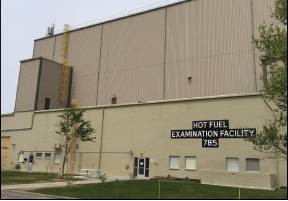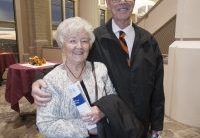By Bryan Clark
KEITH RIDLER/AP
This May 11 photo shows an exterior view of the Hot Fuel Examination Facility at the Idaho National Laboratory, near Idaho Falls.
BOISE — An effort to fund the construction of two new education and research facilities associated with Idaho National Laboratory cleared its first major legislative hurdle Tuesday.
The Senate Education Committee unanimously recommended that Senate Concurrent Resolution 105 be passed by the full Senate.
The resolution would allow the Idaho State Building Authority to float $90 million in bonds to pay for two proposed facilities, which INL would pay back through a lease. One, the Center for Collaborative Computing, would house a next-generation supercomputer for scientific modeling and simulation. The second, the Cybercore Integration Center, would host work and research on cybersecurity.
The land for the new buildings would be donated by Idaho State University, which already owns the parcels near University Place and the Center for Advanced Energy Studies that are being eyed for the two buildings.
Senate Majority Leader Bart Davis, R-Idaho Falls, presented the bill to the committee. He said he hopes the effort will be “as successful as the CAES facility has been,” he said.
CAES, which opened in 2009, was largely financed by about $10 million in bonds, which are expected to be paid off soon.
The two buildings would become a major center for supercomputing and a wide variety of scientific research, INL Director Mark Peters told the committee.
The state’s universities expect that hundreds of students would benefit through use of the new supercomputer, collaborative research projects and new instruction opportunities. The lab expects to create hundreds of new, high-paying jobs. And economic development advocates say it would create tens of millions in local economic impact, including more than 500 long-term jobs and nearly 1,000 short-term construction jobs.
Peters emphasized that the two buildings would help INL and the state’s university system play a vital role in key emerging areas of research, technological development and national security.
“It’s really important to the state, to the universities, to the laboratory and to the nation,” Peters said.
Leaders from Idaho State University, the University of Idaho and Boise State University also testified in favor of the bill.
ISU President Arthur Vailas said the facilities would greatly strengthen the university’s existing specialization in cybersecurity.
“In order to take it to the next level, we need the opportunity to bring in the best intellectual experts,” Vailas said. And a top-of-the-line cybersecurity research center that partners with a national lab would be a major way to attract them.
Idaho Falls Mayor Rebecca Casper testified that the continuing involvement of INL in eastern Idaho has been vital for regional economic development.
“One really couldn’t ask for a better kind of employer,” she said.
The financial arrangement that would be used to pay for the facilities would be “unique,” said Matt Freeman, executive director of the State Board of Education.
The lease agreement outlined in the resolution would be “triple-net,” meaning INL would pay for all maintenance, operations and debt service on the building. INL expects to invest an additional $10 million in improvements to the facility, especially for the installation of the new supercomputer.
It is estimated that it would take a total of 20 years to pay off the bonds. The effort does come with a certain amount of risk, though backers say it’s minimal.
INL would agree to lease the building for at least 15 years, the maximum federal law allows. But Peters said he expects the lease would go on into the indefinite future.
“We intend to be in those (buildings) much longer,” Peters said.
The motion to recommend passage was made by Sen. Bob Nonini, R-Coeur d’Alene, one of the state’s most conservative senators.
“This is such a win-win operation for the state of Idaho, I couldn’t be happier to support it,” he said.
The committee recommended that the Senate floor pass the measure in a unanimous voice vote. The resolution will have to pass on the Senate floor, a House committee and the House floor before heading to Gov. C.L “Butch” Otter’s desk for a signature.





